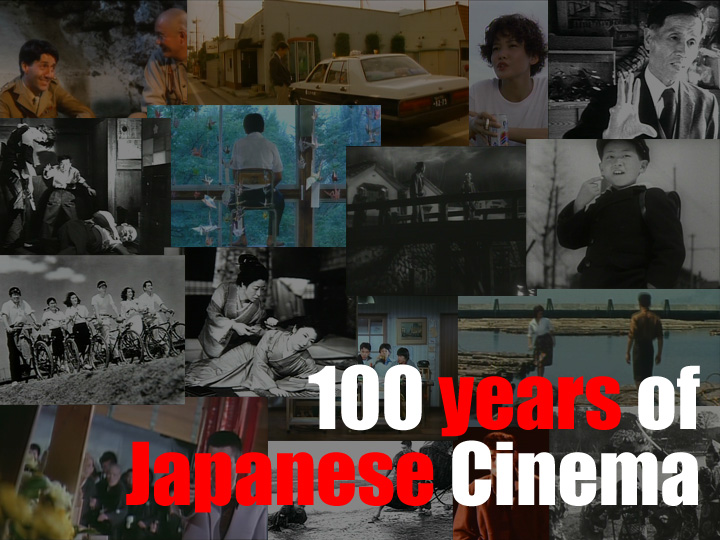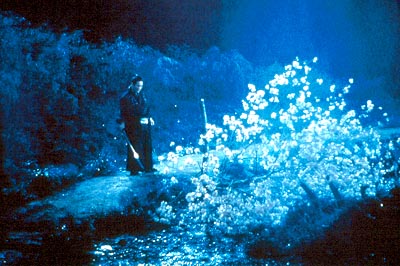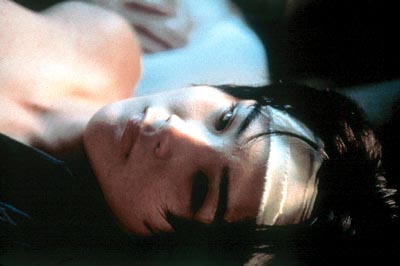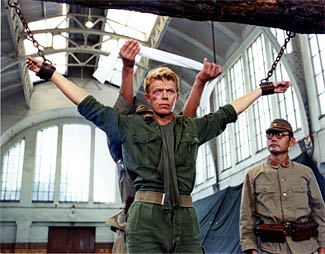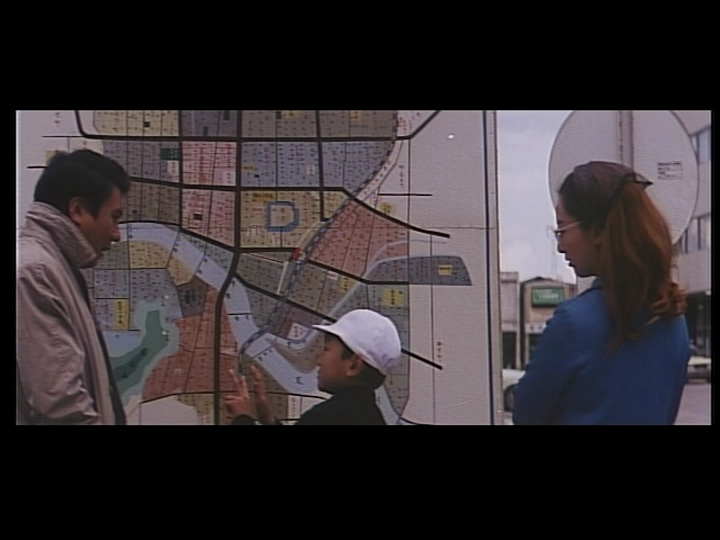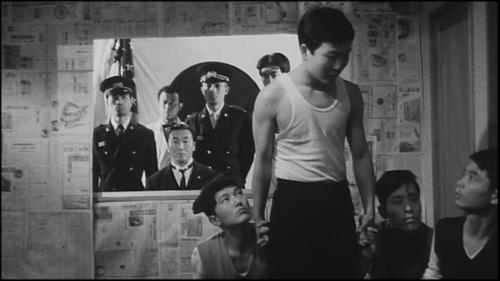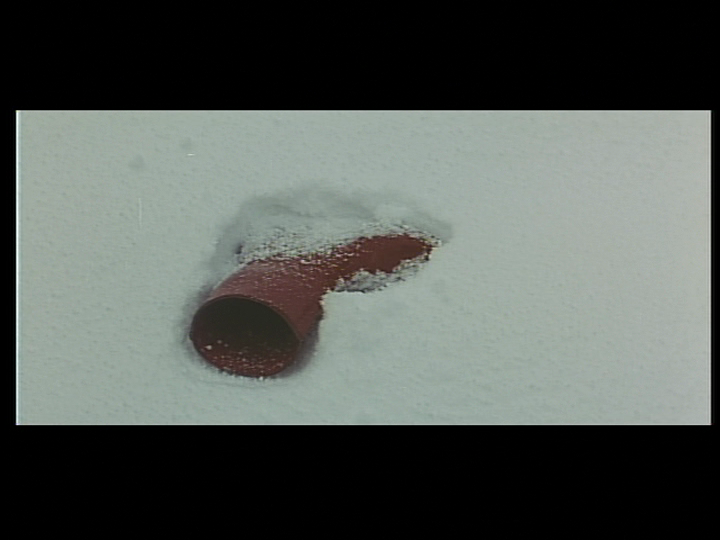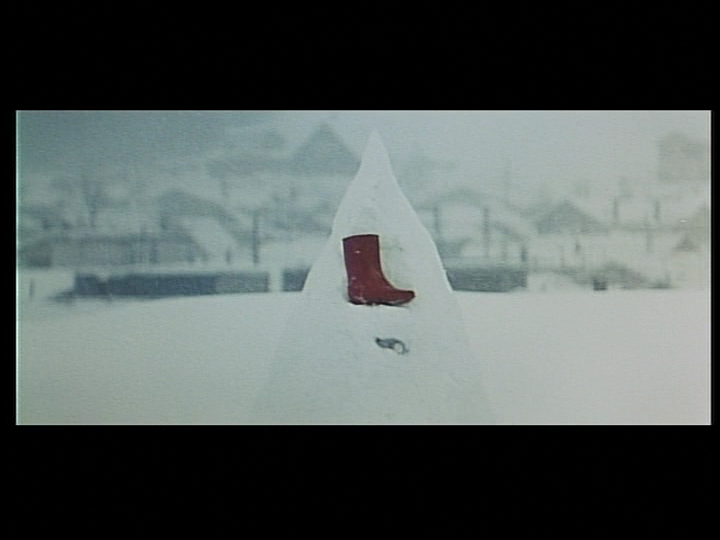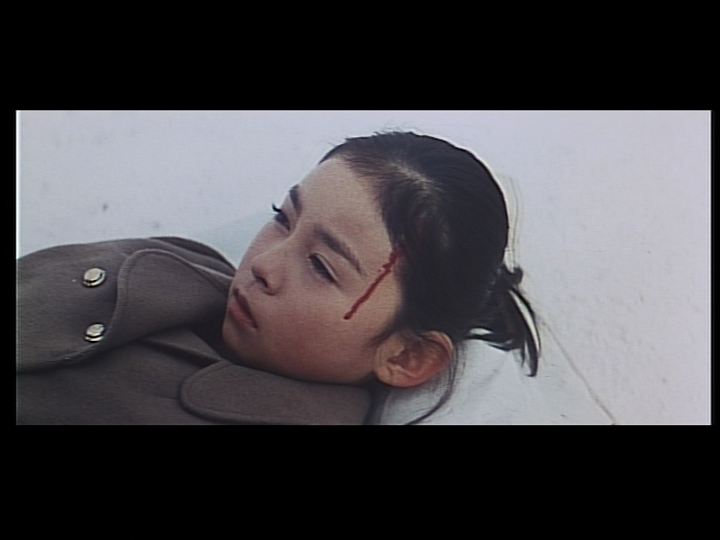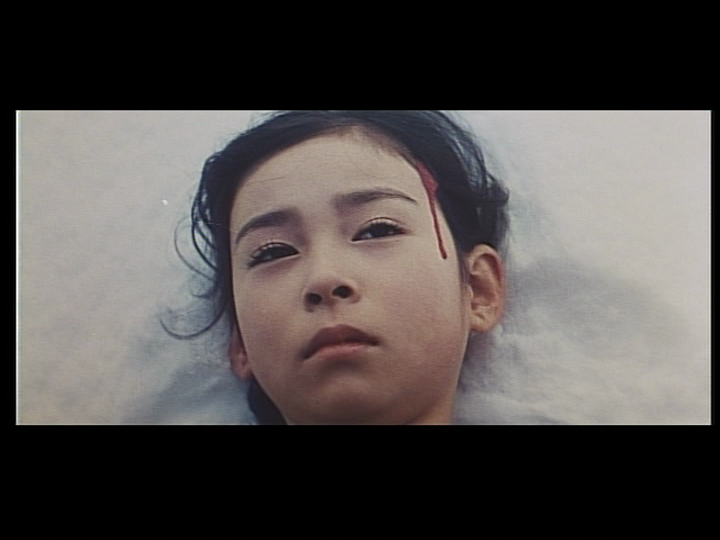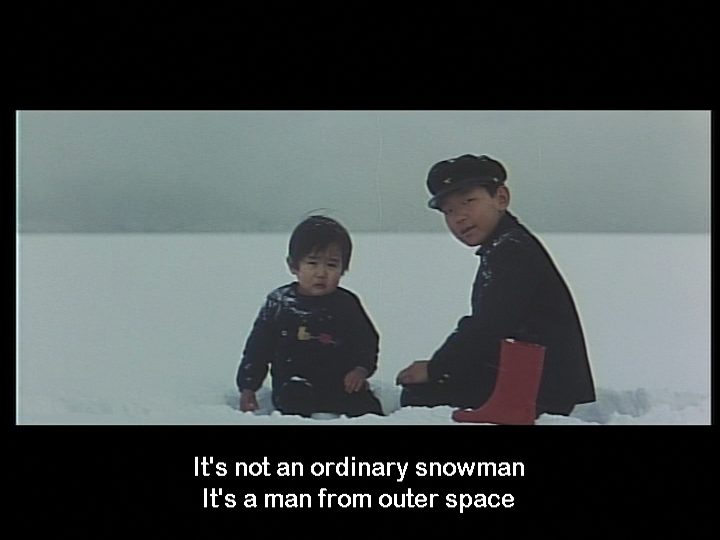From the October 2008 issue of Artforum. (This is also reprinted in my 2010 collection, Goodbye Cinema, Hello Cinephilia.) — J.R.
No major figure in postwar Japanese cinema eludes classification more thoroughly than Nagisa Oshima. The director of twenty-three stylistically diverse feature films since his directorial debut in 1958, at the age of twenty-six, Oshima is, arguably, the best-known but least understood proponent of the Japanese New Wave that came to international prominence in the 1960s and ’70s (though it is a label Oshima himself rejects and despises). Given the size of his oeuvre and the portions that remain virtually unknown in the West — including roughly a quarter of his features and most of his twenty-odd documentaries for television — the temptation to generalize about his work must be firmly resisted.
But to grasp at least how Oshima situates himself, 100 Years of Japanese Cinema, the fifty-two-minute documentary he made for the British Film Institute in 1994, provides a helpful start. That he was offered this assignment at all is comical, given his oft-expressed and unyielding hatred of Japanese cinema as a whole, including his own films. He expressed this aversion in his first major interview in Cahiers du cinéma in March 1970, when he told his interlocutors that Europeans who praised Japanese cinema for its formal beauty should speak more about its content. At the time, one should note, these critics had only recently learned how to love Kurosawa in addition to Mizoguchi (whom they had championed since the ’50s), without having yet discovered Ozu or Naruse. Oshima detested all four. A quarter of a century later, offering a leftist and almost exclusively content-driven survey of his subject in 100 Years, he chose to mind his manners — even if he restricted Ozu, Mizoguchi, and Kurosawa to I Was Born, But . . . (1932), Osaka Elegy (1936), and No Regrets for Our Youth (1946), respectively, and omitted Naruse entirely.¹ In covering the period that encompasses his own career, he obligingly switches from third to first person in his narration, and the eight titles he cites from his own filmography — Cruel Story of Youth (1960), Night and Fog in Japan (1960), Death by Hanging (1968), Boy (1969), The Ceremony (1971), In the Realm of the Senses (1976), Merry Christmas, Mr. Lawrence (1983), and Max, Mon Amour (1986) — constitute (apart from the last item) a credible rundown of his greatest directorial achievements. (Since then, he has made one more feature, in 1999, arguably another aesthetic high point — Taboo, a haunting and dreamlike tale centering on a beautiful, androgynous, and narcissistic merchant’s son recruited to become a samurai warrior in the Shinsengumi militia, a nationalist legion assigned to protect the shogun.²) In 100 Years of Japanese Cinema, Oshima claims that his principal contribution was to introduce new kinds of subject matter relating to politics, war, and sex into the national cinema.

Oshima suggests in the documentary that Max, Mon Amour, shot in Paris with a European cast, may not even be Japanese. Cowritten with Jean-Claude Carrière and produced by Serge Silberman (the two had together famously teamed with Luis Buñuel on his French and Spanish films of the ’60s and ’70s), this comic tale about a British diplomat’s wife (Charlotte Rampling) having a fling with a chimpanzee mostly registers as a failed attempt at Buñuelian whimsy. But the film’s internationalism relates to Oshima’s point: The last line in his commentary equates the future “blossoming” of Japanese cinema with its capacity to “free itself from the spell of Japanese-ness.” And considering how preoccupied with Japan he remains — his ambitious work The Ceremony is virtually an attempt to psychoanalyze the country over a quarter of a century, as Maureen Turim, his most astute American commentator, has implied³ — this sounds like a classic case of a filmmaker turned against himself. He often comes across as a man who hates Japan almost as much as he hates Japanese cinema yet is hard put to come up with any other sustaining topic.
Born in 1932 to an aristocratic Kyoto family with samurai ancestors, Oshima studied law at Kyoto University and became deeply engaged there in the leftist student movement that would become increasingly anti-American and anti-Communist. (The bloody demonstrations against the US-Japanese Security Treaty of 1960 and the internal struggles of the student movement are the primary focus of Night and Fog in Japan.) By the time Oshima turned to filmmaking, in his twenties, he had already come to regard cinema chiefly as a means to political ends.

On a Japan Foundation visitor’s fellowship in 1999, I was able to view some of Taboo’s sets shortly after the film was completed and had been screened for the Japanese press, mostly to favorable reactions. In the mid-’90s, while Oshima was on a speaking tour of the United Kingdom, he had suffered a stroke, leaving the right side of his body paralyzed and delaying the start of shooting. He directed from a wheelchair, and given his failing health, it seems unlikely that he will direct another feature. The filming of Taboo was done in Kyoto, using a few temples for some of the exteriors and the Shochiku studio specializing in period films for everything else. (The studio was the same one where Mizoguchi shot The Story of the Last Chrysanthemums in 1939.) According to a film scholar who followed the shooting, Oshima’s direction focused on the placement and moves of the camera rather than on the actors — many of whom, such as Takeshi Kitano, were among the most popular in Japan and were accorded a fair amount of autonomy.
Ironically and surprisingly, Oshima is perhaps best known in Japan today as a television talk-show host and guest. I saw him once on TV during my visit, and he came across as something like a Japanese Oprah Winfrey. When I later asked leftist film critic Tadao Sato if being on TV had forced Oshima to compromise his politics, he replied that, on the contrary, it had enabled him to express his political positions to a wider audience.
Oshima’s cinema consists of particular interventions in Japan’s internal political debates, and freely draws on forms as well as styles that seem to come from everywhere, including Japan. Some would call this disconcertingly voracious trait “very Japanese,” and it helps to account for the truism that no two Oshima films are alike. Each new feature critiques its predecessors: After vowing to abolish green from his palette in his first foray into color, Cruel Story of Youth, as a way of refusing any trace of domestic tranquillity, he used green frequently and effectively two features later (without suggesting much domestic tranquillity), in his first truly personal work, Night and Fog in Japan [see below], meanwhile countering the earlier film’s neorealist locations and handheld-camera movements with artificially lit theatrical spaces and smooth if restless pans between characters at a wedding party. Both films are steeped in the dark pessimism characteristic of Oshima’s films of the ’60s.
Starting out as a contract director for Shochiku Studios — albeit one who quickly acquired auteurist credentials, as suggested by his brief appearances in some trailers for his first features — he went independent after the political and formal provocations of Night and Fog in Japan prompted the studio to suppress it a few days into its initial run. (His actress wife, Akiko Koyama, who has played in many of his independent films, also started out at Shochiku, though he found most of his other recurring collaborators, such as writer Tamura Tsutomu and cinematographer Akira Takada, only after leaving the studio.) Shochiku went on to distribute some of his independent features, however, and Oshima eventually returned to that studio to make Taboo.
The focus on aggressive or outlaw eroticism in the director’s five most recent features — In the Realm of the Senses; Empire of Passion (1978); Merry Christmas, Mr. Lawrence; Max, Mon Amour; and Taboo — could be seen as a function of his growing political despair, an overall shift in his explorations of freedom from public to private spheres. But this is an inadequate way of summing up these odd films, especially the first and third, which can be described respectively as thoughtful and provocative hard-core porn (which has yet to show in Japan in undoctored form), and a bold foray into bilingual, crosscultural filmmaking that has often been compared to David Lean’s Bridge on the River Kwai (1957) but might now be viewed more interestingly as an anticipation of Clint Eastwood’s recent World War II diptych (though Oshima is more critical of Japan). Merry Christmas could likewise be described as a broaching of a certain politically incorrect homoeroticism, which eventually gets reconfigured in Taboo. Although In the Realm of the Senses — based on the true 1936 story of renegade prostitute Sada Abe, who erotically asphyxiated her lover Kichizo Ishida with his seeming complicity, then severed his penis and testicles and carried them around in her purse for several days — cannot be said to contradict the tragic vision of twentieth-century Japan that underlies Oshima’s work, it may nevertheless qualify as his most celebratory feature, in its emphasis on the pleasure and rapture of sex. By contrast, Merry Christmas, Mr. Lawrence — conceived as a kind of ideological and macho/erotic duel between pop stars David Bowie and Ryuichi Sakamoto in a Japanese POW camp during World War II — more typically views sex in terms that are mainly punitive.
Where Oshima differs most strikingly from an antisentimental, leftist provocateur like Buñuel is in the relative absence of humanism in his work. (Boy, a mainly sympathetic look at a lonely ten-year-old con artist, is a rare exception.) If The Sun’s Burial (1960) — an early shocker about rival street gangs in an Osaka slum — was partly inspired by Buñuel’s Los Olvidados (1950), as the British DVD’s liner notes maintain, the notion of Oshima showing any tenderness toward his doomed punks, as Buñuel does toward Jaibo, is unthinkable — even if Oshima is no less outraged by corpses being dumped like garbage. And the repeated occurrences of sexual assault (mainly rape) in Cruel Story of Youth, The Sun’s Burial, Violence at Noon (1966), Sing a Song of Sex (1967), Death by Hanging, Diary of a Shinjuku Thief (1968), The Man Who Left His Will on Film (1970), Empire of Passion, and Merry Christmas, Mr. Lawrence — usually committed by his protagonists and often seen as acts of rebellion against the Japanese state (a view at least contested in Death by Hanging) — suggest that, with the possible exception of In the Realm of the Senses, feminism and nonviolence are not exactly hallmarks of his leftist positions.
Oshima’s preoccupation with Japan, central to most of his films, has many formal consequences. The most striking of these is a graphic obsession with the national flag that gets applied quite differently — though most often ironically or tragically — from film to film. This fixation, neither as abstract nor as playful as it might first appear, usually reveals profound intellectual and emotional conflicts about his subject matter.
Sometimes his employments are mainly anecdotal — as when for example, near the beginning of In the Realm of the Senses, a little girl exposes an old male beggar’s genitals with the tip of her tiny Japanese flag. And sometimes they are simply emblematic or metaphoric and proliferate in every direction, as in the black-and-white Death by Hanging. The film begins like a documentary about capital punishment (evocative of Alain Resnais’s 1955 Night and Fog in both its exploratory camera movements and the narration’s focus on banal details) before gravitating into a didactic, deconstructive comedy-satire, complete with Brechtian section headings, about the philosophical, existential, ethical, social, racist, and bureaucratic assumptions underlying the attempted execution of a twenty-three-year-old Korean named R for raping and killing two Japanese schoolgirls. The scenario was inspired by the 1958 real-life case of Ri Chin’u, and it is surprising how hilarious Oshima manages to make much of it; the plot and theme development intermittently and improbably call to mind a slapstick version of Native Son. After R strangely refuses to die and undergoes a form of amnesia, state dignitaries and functionaries proceed frantically to reenact his crime to refresh his memory. The execution chamber is at one point theatrically converted into R’s family home, the walls covered by newspaper pages. In a small section of one of these walls, inside what resembles a fairground booth, the public prosecutor and a security guard, with a huge Japanese flag directly behind them, preside over these reenactments. (No less pointedly, an unfurled American flag can also be seen inside this boxed-in space.) Later, R and his sister are discovered jointly using a still bigger Japanese flag as a bedsheet. And in the final sequence, R’s face in close-up as seen through an empty hangman’s noose is made to rhyme eerily with the sizable wall flags that frame all the major concluding speeches.
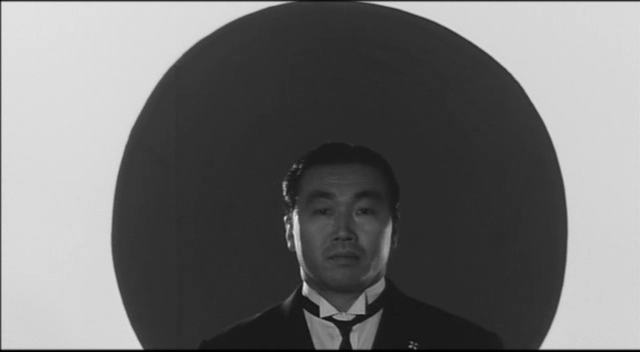
Thematically and plastically, Oshima’s flag obsession goes far beyond Jean-Luc Godard’s ironic uses of tricolored compositions suggested by the French and American flags in some of his more politically oriented pre-1968 color films. In The Sun’s Burial, where the flag is even implicit in the title, we get many apocalyptic images of the setting sun punctuating the grim narrative. In The Ceremony, the obsession arguably has something to do with the film’s compulsive center framing, suggesting a kind of ongoing critique both of rituals (mainly weddings and funerals) and of symmetry within the orderly CinemaScope compositions that frame them — rituals and symmetry that are moreover constantly on the verge of capsizing in various perverse and grotesque ways.

In Boy, which uses ’Scope even more brilliantly, the flag figures in everything from the abstract design behind the credits — a variation on the credits of Sing a Song of Sex (a film featuring an alternate version of the national standard, with a black sun instead of a red one at the center of a white field) — to strategically placed Japanese flags and many rhyming images, such as the splatter of blood on a snow-covered ground and the title hero’s planting of a red boot in the center of a snowman.
In this film, moreover, Oshima creates a potent dialectic between the center framing suggested by the flag and a reverse compositional strategy. The film is based on a famous news story from 1966 about parents who taught their ten-year-old boy to pretend to be hit by cars so they could then collect damages from the drivers via guilt-tripping or threatening to go to the police, the family of four meanwhile moving constantly across the country to stay ahead of the law. So Boy is conceived as a kind of travelogue of perpetual estrangement, frequently locating its characters at the far edges of the frames in order to articulate their profound separation from wherever they happen to be. And the significance of the red boot in the snowman is that it belonged to a little girl accidentally killed in one of the staged accidents.
However one slices up Oshima’s career, it is still hard to reconcile his profile as a mainstream television personality with his commitment to radical politics and with the avant-garde moves of some of his films. But it is important to stress that his avant-garde gestures, even when they yield the throwaway, anything-goes construction of Diary of a Shinjuku Thief or the opaqueness of The Man Who Left His Will on Film, are seldom dilettantish. Tadao Sato has argued that the stripped-down, neotheatrical settings of both Night and Fog in Japan and Death by Hanging partly derived from constraints of time and budget, and one might add that Oshima’s more radical representational strategies, including his diverse uses of the flag, are generally dictated by intellectual content. Maureen Turim aptly notes that R in Death by Hanging evokes X, A, and M, the central characters of Resnais’s Last Year at Marienbad; she could have added that Oshima’s deconstructive methodology throughout the film often suggests a highly politicized retooling of some of Marienbad’s procedures involving memory and persuasion.
Deeply marked by their sense of historical moment, regardless of whether they happen to be contemporary or period films, Oshima’s most potent works — Death by Hanging, Boy, and, more debatably, In the Realm of the Senses — are significantly all inspired by newspaper stories. Whether one winds up regarding their flamboyance as sincere or opportunistic, their mastery in alternating silence with imaginative employments of sound, mobile mise en scène with the sudden insertions of stills, and subjective fantasies with social reality is irrefutable. It is characteristic of Oshima’s flexibility (or fickleness) that he can cheerfully jettison his own carefully established codes of realism at the drop of a hat, such as when he allows David Bowie in Merry Christmas, Mr. Lawrence, Oshima’s most mainstream picture, to survive a firing squad without explanation. If we are still puzzling over the logic and fractured unity of this iconoclast’s work, it is entirely to his credit that he invites and shares our curiosity.
NOTES
1. In fact, though Oshima has never been any sort of cinephile, even when he functioned as a film critic, at least two of these filmmakers have marked him, in very different ways. He once admitted that seeing the aforementioned Kurosawa film at the age of fourteen was what persuaded him to attend Kyoto University. And much of Taboo registers as a multifaceted tribute to Mizoguchi — the long takes, the nearly constant camera movements, the Kabuki-like ostentation, and the ghostly and atmospheric studio expressionism. There is even a direct allusion in the dialogue to the eighteenth-century literary source of Mizoguchi’s Ugetsu, Akinari Ueda’s classic Tales of the Moonlight and Rain.
2. “Taboo” is not an accurate translation of the original title, Gohatto — a somewhat old-fashioned term meaning “against the law” or “against the laws.” (One fascinating aspect of the Japanese language from a Western perspective is its lack of distinction between singular and plural nouns, which injects ambiguity into many titles.)
3. See Maureen Turim, The Films of Oshima Nagisa: Images of a Japanese Iconoclast (Berkeley: University of California Press, 1998), 117–23.


